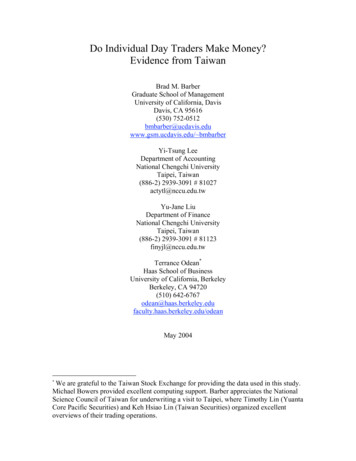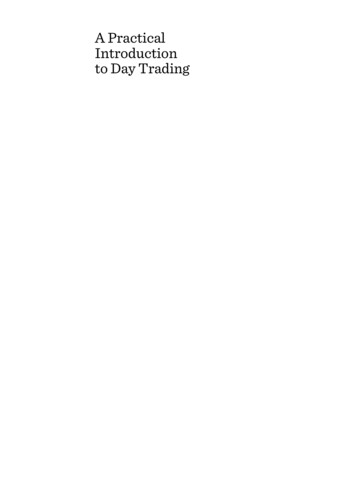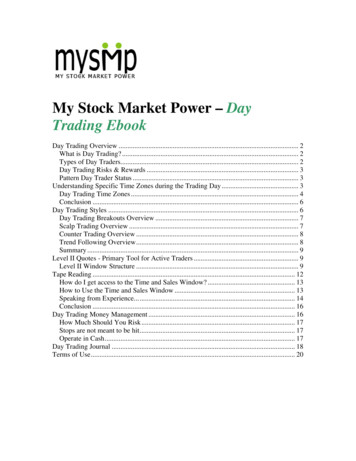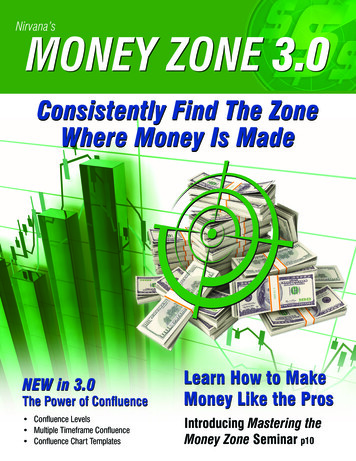
Transcription
Do Individual Day Traders Make Money?Evidence from TaiwanBrad M. BarberGraduate School of ManagementUniversity of California, DavisDavis, CA 95616(530) 752-0512bmbarber@ucdavis.eduwww.gsm.ucdavis.edu/ bmbarberYi-Tsung LeeDepartment of AccountingNational Chengchi UniversityTaipei, Taiwan(886-2) 2939-3091 # 81027actytl@nccu.edu.twYu-Jane LiuDepartment of FinanceNational Chengchi UniversityTaipei, Taiwan(886-2) 2939-3091 # 81123finyjl@nccu.edu.twTerrance Odean*Haas School of BusinessUniversity of California, BerkeleyBerkeley, CA 94720(510) ey.edu/odeanMay 2004*We are grateful to the Taiwan Stock Exchange for providing the data used in this study.Michael Bowers provided excellent computing support. Barber appreciates the NationalScience Council of Taiwan for underwriting a visit to Taipei, where Timothy Lin (YuantaCore Pacific Securities) and Keh Hsiao Lin (Taiwan Securities) organized excellentoverviews of their trading operations.
Do Individual Day Traders Make Money? Evidence from TaiwanAbstractWhen an investor buys and sells the same stock on the same day, he has made a daytrade. We analyze the performance of day traders in Taiwan. Day trading by individualinvestors is prevalent in Taiwan – accounting for over 20 percent of total volume from1995 through 1999. Individual investors account for over 97 percent of all day tradingactivity. Day trading is extremely concentrated.About one percent of individualinvestors account for half of day trading and one fourth of total trading by individualinvestors. Heavy day traders earn gross profits, but their profits are not sufficient to covertransaction costs. Moreover, in the typical six month period, more than eight out of tenday traders lose money. Despite these bleak findings, there is strong evidence ofpersistent ability for a relatively small group of day traders. Traders with strong pastperformance continue to earn strong returns. The stocks they buy outperform those theysell by 62 basis points per day. This spread is sufficiently large to cover transactioncosts.
When an investor buys and sells the same stock on the same day, he has made aday trade. At the end of the last millennium and a long bull market in U.S. equities, daytrading grew in popularity. In 1999, The Electronic Trade Association estimated that4,000 to 5,000 people traded full time through day trading brokerages1 and accounted fornearly 15 percent of daily volume on NASDAQ.2 By most accounts, the poor returns onU.S. stocks from 2000 to 2002 squelched day trading. However, as the U.S. marketearned strong returns in 2003, day trading made a comeback.3In September 1999, the Senate Permanent Subcommittee on Investigations heldthe first congressional hearing on day trading. In July 2000, the subcommittee issued itsfinal report. The report concluded that (p.2) “a growing number of people are giving uptheir existing careers or withdrawing their savings to become full-time professional daytraders.” Concurrent investigations were launched by the SEC, NASD, NYSE, andseveral state regulatory bodies. All of these investigations expressed concerns about thepotentially deceptive advertising practices employed by day trading firms. As a result ofthese investigations, the NYSE and NASD adopted rules in September 2001 that requiredday trading firms to make a determination that day trading is appropriate for a particularcustomer.Do day traders make money? This was a central question in the investigationsdescribed above. Unfortunately, to date, there is no comprehensive empirical evidenceavailable to answer this question. Though the investigations contained some analyses ofthe profitability of day trading, these analyses were largely limited to a handful ofaccounts.For example, the North American Securities Administrators Associationsponsored a widely cited study of the profitability of 26 day traders at All-Techbrokerage, a brokerage that catered to day traders and was a target of the Senate1Randy Whitestone and Phil Serafino, Day Traders’ Invasion, BLOOMBERG, May 1999, at 36, 39.Britt Tunick, Day Traders Working Hard to Influence How the Profession is to be Defined, SEC. WEEK,May 24, 1999.3John Hechinger and Jeff Opdyke, Day Trading Makes a Comeback and Brokers Vie for the Business,Wall Street Journal, September 30,2003, p.A1. Matt Krantz, Day Traders Make a Comeback, USA Today,July 28, 2003.21
investigations. Drawing conclusive inferences from such a small sample of accounts froma brokerage firm under investigation is difficult.Unlike the studies cited in congressional and SEC investigations, two small scaleacademic studies of day trading provide evidence that day trading can be profitable.Harris and Schultz (1998) analyze the day trading of Small Order Execution System(SOES) bandits using trading records from two brokers. To do so, they analyze roughly20,000 trades over a three week period. Though the SOES traders lose money almost asfrequently as they make money, they earn a small average profit per trade. Similarly,Garvey and Murphy (2001) analyze the trading of 96,000 trades made by fifteenproprietary day traders—traders who use a firm’s capital, pay no commissions, and profitshare with the firm—at a direct access broker during three months in 2000. They toofind these fifteen day traders are able to make money on their day trading activitiesprimarily by placing limit orders on electronic crossing networks (ECNs) that are insidethe current best quotes offered by NASDAQ dealers. Seasholes and Wu (2004) examinethe trades of ten extremely active traders on the Shanghai Stock Exchange. These tradersearn substantial profits through buying shares on days that stocks hit their upper pricelimits and quickly selling those shares the following day.Linnainmaa (2003) analyzes 7,686 investors who complete at least one roundtripintraday transaction. These investors are far less active than those studied by Harris andSchultz (1998) and Garvey and Murphy (2001). The majority of these investors day tradeon only one or two occasions and, in aggregate, these investors complete only 185,000day trades over a two and a half year period (November 1998 through May 2000).Linnainmaa reports that the net returns of these investors are lower than those of a controlsample.In contrast to these smaller scale studies of day trading, we provide acomprehensive analysis of the profitability of all day trading in Taiwan over a five yearperiod. During an average six month period, we identify over 130,000 investors whotransact at least NT 1.5 million in day trades and over 9,000 who transact at least NT2
90 million in day trades.4 To do so, we use a unique and remarkably complete dataset,which contains the entire transaction data, underlying order data, and the identity of eachtrader on the Taiwan Stock Exchange (TSE) – the World’s twelfth largest financialmarket. With these data, we provide a comprehensive accounting of the profitability ofday traders during the period 1995 through 1999.Taiwan provides a particularly appropriate setting to analyze the profitability ofday trading. By most accounts, day trading has been a fixture on the TSE for decades.Consistent with these assertions, day trading accounts for over 20 percent of tradingvolume in Taiwan during our 1995 to 1999 sample period (see Figure 1). Virtually all daytrading (97.5 percent) can be traced to individual investors in Taiwan. In the typicalmonth, 15 percent of individual investors who trade on the TSE engage in at least oneday trade.To analyze the profits earned by day traders, we follow a simple two-stepprocedure. First, we identify day traders. Second, we analyze the profits earned on allsubsequent trades made by investors identified as day traders.We define day trading as the purchase and sale of the same stock on the same dayby an investor. Using this definition, we classify investors who made at least NT 90million of day trades during a six-month period as heavy day traders. In the averagemonth, about 900,000 individual investors trade on the TSE. Of these investors, aboutone percent are classified as heavy day traders. These heavy day traders account for overhalf of all individual day trading activity and one fourth of individual trading volume.We then analyze the profitability of trades made by these investors in the monthfollowing their identification as heavy day traders. In aggregate, these heavy day tradersearn mean daily gross profits (before transaction costs) of NT 36.4 million, but daily netlosses (after a reasonable accounting for transaction costs) of NT 68.9 million. Both the4The average exchange rate that prevailed during our sample period was approximately NT 30 per US 1.Thus NT 90,000,000 is approximately US 3,000,000.3
gross profits and net losses of these day traders are reliably different from zero. In otherwords, day traders are able to execute trades at favorable prices, though not sufficientlyfavorable to cover reasonable transaction costs.Do heavy day traders perform better than occasional day traders? To address thisquestion, we split day traders into categories based on their past levels of day tradingactivity. This analysis indicates heavy day traders perform better than occasional daytraders, though neither group is able to earn sufficient profits to cover transaction costs.Do day traders with past profits subsequently outperform those with past losses?To address this question, we split day traders into categories based on their trading profitsduring the past six months. The analysis reveals a clean monotonic relation between pasttrading profits and subsequent returns. Day traders who historically earned net profitscontinue to earn profits net of a reasonable accounting for transaction costs.Do day traders demand or supply liquidity? To address this question, we classifytrades as passive, aggressive, or indeterminate. We find that 2/3rds of trades placed byday traders are aggressive while only ¼ are passive. Nearly 3/4th of the trades placed byheavy day traders are aggressive, while only 1/6th are passive. In contrast, Linnainmaa(2003) reports that slightly over half of trades placed by 7,686 Finnish day traders areliquidity supplying.Our main empirical findings can be summarized succinctly. Heavy day tradersappear to trade at favorable prices, but only a select few are sufficiently savvy toconsistently earn profits net of their trading costs. More than eight out of ten day traderslose money in a typical semiannual period.The remainder of this paper is organized as follows. We discuss Taiwan marketrules, our dataset, and methods in Section I. We present results in Section II, followed bya discussion and concluding remarks.4
I. Background, Data, and MethodsI.A.Taiwan Market RulesBefore proceeding, it is useful to describe the Taiwan Stock Exchange (TSE). TheTSE operates in a consolidated limit order book environment where only limit orders areaccepted. During the regular trading session, from 9:00 a.m. to noon during our sampleperiod, buy and sell orders can interact to determine the executed price subject toapplicable automatching rules.5 Minimum tick sizes are set by the TSE and varydepending on the price of the security. Effective November 2, 1993, all securities listedon the TSE are traded by automatching through TSE’s Fully Automated SecuritiesTrading (“FAST”) system. During our sample period, trades can be matched one to twotimes every 90 seconds throughout the trading day. Orders are executed in strict price andtime priority. An order entered into the system at an earlier time must be executed in fullbefore an order at the same price entered at a later time is executed. Although marketorders are not permitted, traders can submit aggressive price-limit order to obtainmatching priority. During our study period, there is a daily price limit of seven percent ineach direction and a trade-by-trade intraday price limit of two ticks from the previoustrade price.Since our analysis focuses on day trading, an important consideration istransaction costs. The TSE caps commissions at 0.1425 percent of the value of a trade.Some brokers offer lower commissions for larger traders – an issue that we discuss ingreater detail later in the paper. Officials at brokerage firms and the TSE indicated to usthat the largest commission discounts offered are 50 percent (i.e., a commission ofroughly 7 basis points); these same officials estimated the trade-weighted commissionpaid by market participants to be about 10 basis points. Taiwan also imposes atransaction tax on stock sales of 0.3 percent.5Trading also occurred on Saturdays during most of our sample period. Before December 1997, Saturdaytrading occurred from 9:00-11:00. From January to March, 1998, stocks were traded only on the secondand the fourth Saturday in each month. From April 1998 to Decebmber 2000, Saturday trading occurredfrom 9 am to noon. From 2001 on, there has been no trading on Saturday.5
I.B.Trades Data and Descriptive StatisticsWe have acquired the complete transaction history of all traders on the TSE fromJanuary 1, 1995, through December 31, 1999. The trade data include the date and time ofthe transaction, a stock identifier, order type (buy or sell -- cash or margin), transactionprice, number of shares, a broker code, and the identity of the trader. The trader codeallows us to broadly categorize traders as individuals, corporations, dealers, foreigninvestors, and mutual funds. The majority of investors (by value and number) areindividual investors. Corporations include Taiwan corporations and government-ownedfirms (e.g., in December 2000 the government-owned Post, Banking, and InsuranceServices held over NT213 billion in Taiwanese stock). Dealers include Taiwanesefinancial institutions such as Fubon Securities, Pacific Securities, and Grand gn banks,insurancecompanies, securities firms, and mutual funds. During our sample period, the largestforeign investors are Fidelity Investments, Scudder Kemper, and Schroder InvestmentManagement. Mutual funds are domestic mutual funds, the largest being ABNAMRO Asset Management with NT82 billion invested in Taiwanese stocks inDecember 2000.We define day trading as the purchase and sale, in any order, of the same stock onthe same day by an investor. Specifically, if an investor buys and sells the same stock onthe same day, we calculate the number of shares bought (Sb), the number of shares sold(Ss), the average buy price (Pb), and the average sales price (Ps). The value of day tradingis defined as Pb*min(Sb,Ss) Ps*min(Sb,Ss). Over our sample period, day tradingaccounted for more than 20 percent of the total dollar value of trading volume. Most daytrading (64 percent) involves the purchase and sale of the same number of shares in astock over the course of one day (i.e., most day trades yield no net change in ownership atthe close of the day).In table 1, we present descriptive statistics on overall trading activity and daytrading by investor categories. On the average day, the total value of buys and sells is NT 170 billion. Individual investors account for almost 90 percent of this trading6
activity. Individual investors account for an even larger fraction of day trading (97percent). While day trading accounts for 22 percent of total individual trading activity,day trading accounts for only five percent of institutional trading. Among institutions,corporations are the most active day traders (both by the value of day trading and theproportion of trading activity attributable to day trading).Individuals and corporations are free to short sell, though dealers, mutual funds,and foreigners are prohibited from doing so on the TSE. These short sale restrictionsmight partially explain the tendency for day trading to concentrate among individualinvestors and corporations. In contrast to U.S. markets, dealers are not active providersof liquidity. Though dealers are required to “efficiently adjust the demand and supply inthe market depending on the market situation, and ensure that the formation of fair priceand its sound operation are not harmed,” dealers face no specific penalties for failing tomeet this requirement. Dealer trades emanate from their proprietary trading activity.Based on our discussions with dealers in the TSE, the majority of this proprietary tradingis not necessarily intended to provide liquidity. Chae and Wang (2003) also report thatTSE dealers are not net providers of liquidity.I.C.Identification of Day TradersTo analyze the performance of day traders, we follow a simple two stepprocedure. First, we identify day traders based on the history of their trading activity.Second, we aggregate the trades made by this investor group in a subsequent period andanalyze the performance of the aggregated trades. It is important to note that period usedto identify day traders always precedes the period used to evaluate their performance.This simple rule precludes the possibility that our results are being driven by anyendogeneity that may exist between contemporaneous performance and day trading (e.g.,good performance may cause investors to increase their day trading activity). In sectionII.E. and Table 7, we document that day trading activity and profitability is indeedendogenous; day traders with past profits increase their day trading activity significantlymore than day traders with past losses.7
We focus on individual day traders, since they account for the vast majority ofday trading in Taiwan. We partition individual day traders in two ways – based on theirpast day trading activity and their past trading profits. Consider first the partition on pastday trading activity. In month t, we sum the total value of day trading (DT) in months t-6to t-1. We then partition investors into seven mutually exclusive categories based on theirpast trading activity:1.2.3.4.5.6.7. NT 600 million NT 240 million NT 90 million NT 15 million NT 1.5 million NT 0.3 million DTDTDTDTDTDTDT NT 600 million NT 240 million NT 90 million NT 15 million NT 1.5 million NT 0.3 millionUsing these partitions, we analyze the trading and performance of each group in month t,where category assignments are updated monthly. Note that this categorization isexhaustive. Investors who rarely or never day trade fall into our seventh category (DT NT 300,000).In table 2, panel A, we present descriptive statistics on the overall trading activityand day trading for each of these partitions. The partitions are based on day trading inmonths t-6 to t-1, while the descriptive statistics in the table describe trades made by eachgroup in month t. Our simple identification procedure does a good job of identifyingheavy day traders. Investors who fall into our top day trading group continue to tradeheavily (the average value of their daily trades exceeds NT 13 million) and over half oftheir trades are day trades. In combination, the top three trading groups represent aboutone percent of investors who trade in the average month (9,389 out of 925,841) accountfor roughly half of all day trading. Overall trading (i.e., day trades and non-day trades) bythis one percent of investors accounts for one fourth of total trading volume by allindividual investors. In contrast, investors with little or no past day trading activityrepresent 78 percent of investors who trade in the average month, account for 25 percentof overall trading volume, but only account for five percent of day trading activity.8
Consider second the partition which is based on on past trading profits. In montht, we calculate the mean standardized trading profits, net of transaction costs, duringmonths t-6 to t-1 as follows. We do not observe transaction costs directly, so we assumethat investors face a one-way commission of 7 basis points (roughly half the maximumcommission rate of 14.25 basis points). Our discussions with officials at the TSE indicatethat heavy traders might receive a discount of up to 50 percent on the maximumcommission level. In addition, these officials estimated the average commission faced byinvestors on the TSE was 10 basis points. Thus, our assumption of a commission of 7basis points is likely to underestimate true costs; we assume a higher 10 basis pointswhen evaluating the performance of subsequent trades. Sales are taxed at 30 basis points.Thus, for each investor, for days on which the investor trades, we calculate net dailyprofits on day IJ (ʌIJ) as:S W Sb ( Pc Pb ) Ss Pc Ps.0007( Sb PbS s Ps ) .003( S s Ps ) ,where Sb and Ss are the total number of shares bought and sold, Pb and Ps are the averagepurchase price and the average sale price, and Pc is the closing price of the stock on day IJ.The summation is across all stocks traded (regardless of whether the trade was part of aday trade) on day IJ by a particular investor. This calculation yields a time series of dailyintraday trading profits for each trader over the six months spanning t-6 to t-1. Wecalculate the mean standardized profit as the mean daily profit divided by the standarddeviation of daily profits: S / VS. To rank an investor in month t, we require at least 35observations (days) of daily profits in months t-6 to t-1.6 We partition investors intoseven mutually exclusive categories based on their past trading profits:1.0.2 S / VS2.0.1 S / VS 0.23.0 S / VS 0.14. -0.2 S / VS 05. -0.4 S / VS -0.2S / VS -0.46.6To ensure that this analysis yields predominantly day traders, we also throw out any investor that did notengage in at least three day trades in month t-1.9
Using these partitions, we analyze the trading and performance of day traders in month t,where category assignments are updated monthly.In table 2, panel B, we present descriptive statistics on the overall trading activityand day trading by for each of these profit partitions. Individual investors with no ranking(i.e., less than 35 observations of day trading profits in the prior six months) account for59 percent of total trading volume and 31 percent of day trading activity. Day tradesaccount for 12 percent of total trading for the unranked investors. In contrast, a highproportion of trades by ranked investors are day trades – ranging from 32 percent to 53percent.I.D.Performance MeasurementSince we focus on day traders, we measure performance from the transaction timeto the close of trading on the same day. (Our results are qualitatively similar using longerevaluation periods of up to ten days.) On each day for each stock, we sum shares boughtand shares sold by a particular investor group. For example, to analyze the performanceof heavy day traders, on each day we calculate their gross dollar profits as:S Wgross Sb ( Pc Pb ) Ss Pc Ps .In contrast to our previous calculations for ranking purposes, which are done at theinvestor level, the shares bought, share sold, average purchase price, and average salesprice are derived from all transactions made by investors within a particular group (i.e., atthe group level). The summation is across all stocks traded by a group on day IJ. Thiscalculation yields a time series of daily gross dollar profits for the group. Statisticalsignificance is based on the time series mean and standard deviation of daily dollarprofits.We supplement this analysis with a calculation of gross returns. We calculate thedifference between the returns on stocks bought by a particular group and the returns onstocks sold (RIJ) as: S P S P S P S PRW b cs cb bs s.10
Again, summations are across all stocks traded on day IJ. Thus, to calculate the returns tostocks bought, we compare the total value of buys to the closing value of positionsbought. This calculate yields a time series of daily returns. Statistical significance isbased on the time series mean and standard deviation of daily returns.Finally, we calculate the net daily profits earned by a particular group bysubtracting commissions (assumed to be 10 basis points) and transaction taxes (30 basispoints on sales) from the daily gross profits as:S W Sb ( Pc Pb ) Ss Pc Ps.001( Sb PbS s Ps ) .003( S s Ps ) .The summation is across all stocks traded by a particular group on day IJ. Statisticalsignificance is based on the time-series mean and standard deviation of the daily netdollar profits.II. ResultsII.A. Performance before CostsIn table 3, we present the gross performance (before transaction costs) forinvestors partitioned on the basis of their past day trading volume (panel A) and the pastprofitability of their trading (panel B). Panel A reveals that heavy day traders have stronggross performance, while less active day traders have negative gross returns and sufferlosses even before considering costs associated with their trading.Consider the day traders in our top three groups. (i.e., traders who day traded aminimum of NT 90 million in the prior six months). Note that a minimum of NT 90million in day trades over a six month period implies mean day trading activity of almost NT 650,000 (slightly more than US 20,000 per day). When combined, 43 percent ofthe total trading activity by these groups can be traced to their day trading (see table 2,panel A). In combination, these groups earn gross profits of NT 36.4 million (see table3, panel A).Our main results compare transaction prices to closing prices on the same day. Anatural question that this approach raises is whether the results differ if we evaluate trade11
performance over longer periods. To address this question, we track the performance ofstocks bought and stock sold by a particular group for up to ten days following thetransactions.7 The gross profits earned by our heavy day trading groups do not changewhen we consider evaluation periods up to ten days. For example, the top trading groupearns mean daily gross profits of NT 21.4 million when we compare transaction pricesto closing prices on the same day (table 3, panel A); at a horizon of ten days, the meandaily gross profit of this groups is NT 23.5 million. When combined, the profits of thetop three trading groups change little at holding periods up to ten days (from NT 36.4million to NT 34.7 million at an assumed holding period of ten days). These results arenot surprising, since a significant fraction of trades by these trading groups are day tradesand thus would not contribute profits (or losses) after the trade date. In contrast, thelosses of less active traders grow as we consider longer holding periods. For example, thelosses of the least active trading group – many of whom engage in no day trading – growfrom NT 24.3 million over a single day to NT 32.1 million over a ten day horizon.Analyzing these same data, Barber, Lee, Liu, and Odean (2003) document that, inaggregate, the trades of all individual investors lose money before accounting fortransaction costs and that these losses grow at longer horizons. Thus the trades of bothless active day traders and individual investors in aggregate lose money, while the tradesof heavy day traders earn gross profits.In panel B, table 3, we analyze day traders partitioned on the basis of pastprofitability. There is a monotonic relation between past profitability and subsequentreturns; the most profitable traders continue to earn superior returns, while the leastprofitable traders continue to suffer losses. By construction (since we require a minimumof 35 days to rank an investors on the basis of their past profitability), each of our profitpartitions consists of relatively active day traders (see table 2). Thus, not surprisingly,the mean gross daily profits of each group do not change significantly when we evaluatetheir trades over longer horizons.7.We employ methods identical to those outlined in detail in Barber, Lee, Liu, and Odean (2003).12
II.B. Performance after Trading CostsIn table 4, we present results net of trading costs (10 basis points for commissionsand 30 basis points for the tax on sales). Panel A reveals that the strong grossperformance of heavy day traders does not translate into profits net of transaction costs.In the last two columns of the table, we present the mean number of accountscontributing trades to our analysis and the average profit (or loss) per account. Net offees, the average account in the heavy day trader partition (greater than NT 600 millionin day trading activity over the prior six months) incurs daily losses of NT 8,443.Accounts with little or no prior day trading activity incur much smaller daily losses,largely because they trade less actively.In contrast, panel B reveals that day traders with the most profitable past tradingactivity continue to earn profits net of costs. The net profits of the top two partitions arereliably positive. Though, on average, only 393 accounts contribute trades to the topprofit partition, these accounts earn average daily profits of NT 7,532. Given 280trading days in the average year, this translates into an annual income of NT 2.1 million.The mean annual income in Taiwan in 1999 was NT 390,000 and, according to thedirectorate-general of budget, accounting, and statistics in Taiwan, the mean annualsalary for employees of financial institutions (including banks, securities firms, and realestate agencies) is around NT 800,000. Thus, an investor who mimicked the trades ofour top profit partition would earn an annual income that is well above average.The fact that we are able to identify a persistently strong group of day tradersindicates that day trading is not entirely a fool’s game. Some day traders are able tomake money net of transaction costs. Coval, Hirshleifer, and Shumway (2003) documentpersistence in the gross performance of purchases made by successful investors at a largeU.S. discount brokerage firm. Their sample consists of individual investors, the majorityof whom are not day t
trade. We analyze the performance of day traders in Taiwan. Day trading by individual investors is prevalent in Taiwan Πaccounting for over 20 percent of total volume from 1995 through 1999. Individual investors account for over 97 percent of all day trading activity. Day trading is extremely concentrated. About one percent of individual


![Welcome [dashdiet.me]](/img/17/30-day-weight-loss-journal.jpg)







